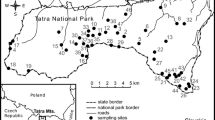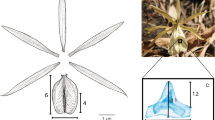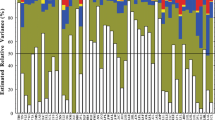Abstract
A group of representative species of the genus Puya was studied to determine if there are allometric relationships between vegetative and floral parts, whether these relationships correlate with their pollination system and if plant size is correlated with elevation and latitude. Fifty-three species representing the morphological variation and distribution of the genus were studied. Total plant height, as well as leaf, inflorescence, petal and sepal length were measured and these data subjected to univariate and multivariate analyses. To test for correlation between plant size and altitudinal and latitudinal distribution, ANOVAs were performed. When the pollination system of a species is known, additional multivariate and univariate analyses were also performed. The results indicate that the characters studied are correlated with a size component, exhibiting positive allometry for sepal and petal length and negative allometry for leaf length. Inflorescence length is an isometric character. There was no significant correlation between plant size and altitudinal or latitudinal distribution. The ANOVAs show that the only character correlated to pollinator type was petal length. Small plants with small flowers are correlated to pollinators such as insects, while medium to large plants with medium to large-sized flowers are correlated with pollinators such as birds and bats. Large plants have small flowers, that are more evident and attract more pollinators.
Similar content being viewed by others
References
D. H Benzing (2000) Bromeliaceae profile of an adaptive radiation Cambridge University Press Cambridge
W. J Bond J. J Midgley (1988) ArticleTitleAllometry and sexual differences in leaf size Amer. Naturalist 131 901–910 Occurrence Handle10.1086/284830
F. L Brookstein (1991) Morphometric tools for landmark data Cambridge University Press New York, USA
H. A Chaparro (2002) Efecto de la predación de inflorescencias de Puya trianae por moscas (Phoridae) sobre la producción de frutos en el parque nacional natural Chingaza (Cundinamarca, Colombia). Resumen. VII Congreso Latinoamericano de Botánica Cartagena de Indias Colombia
L. F Delph (1994) Flower size dimorphism in plants with unisexual flowers D. G Lloyd S. C. H Barrett (Eds) Floral biology: Studies on floral evolution in animal-pollinated plants Chapman and Hall New York, USA 217–237
S. E Donnelly C. J Lortie L. W Aarssen (1998) ArticleTitlePollination in Verbascum thapsus (Scrophulariaceae): The advantage of being tall Amer. J. Bot 85 1618–1625
E Elle R Carney (2003) ArticleTitleReproductive assurance varies with flower size in Collinsia parviflora (Scrophulariaceae) Amer. J. Bot 90 888–896
K Faegri L Pijl Particlevan der (1971) The principles of pollination ecology Pergamon Press Oxford, UK
M. B Foster (1950) ArticleTitlePuya, the pineapple's Andean ancestor Natl. Geogr. Mag 48 463–480
T. J Givnish K. L Sytsma J. F Smith W. J Hahn D. H Benzing E. M Burkhardt (1997) Molecular evolution and adaptive radiation in Brocchinia (Bromeliaceae: Pitcairnioideae) atop tepuis of the Guayana shield T. J Givnish K. J Systma (Eds) Molecular evolution and adaptive radiation Cambridge University Press Cambridge 259–311
V Grant K. A Grant (1965) Flower pollination in the Phlox family Columbia University Press New York, USA
J. F Hair R. E Anderson R. L Tatham W. C Black (1998) Multivariate data analysis. Upper Saddle River Prentice Hall NJ, USA
P Harris (1985) ArticleTitleTesting for variance homogeneity of correlated variables Biometrika 72 103–107
O Hedberg (1969) ArticleTitleEvolution and speciation in a tropical high mountain flora Biol. J. Linn. Soc 1 135–148
O Hedberg (1970) ArticleTitleEvolution of the afroalpine flora Biotropica 2 16–23
A. J Henderson (2002) ArticleTitlePhenetic and phylogenetic analyses Reinhardtia (Palmae) Amer. J. Bot 89 1491–1503
C Herrera (1996) Floral traits and plant adaptations to insect pollinators: a devil's advocate approach D. G Lloyd S. C. H Barrett (Eds) Floral biology: studies of floral evolution in animal-pollinated plants Chapman and Hall New York 65–87
A. B Hingston P. B McQuillan (2000) ArticleTitleAre pollination syndromes useful predictors of floral visitors in Tasmania Austral. Ecology 25 600–609 Occurrence Handle10.1046/j.1442-9993.2000.01059.x
D. C Hoaglin F Mosteller J. W Tukey (1993) Understanding robust and exploratory data analysis John Wiley & Sons New York, USA
C Hornung-Leoni V Sosa (2004) ArticleTitleUses of the giant bromeliad, Puya raimondii Journal Bromeliad Society 54 3–8
J. E Jackson (1991) A user's guide to principal components Wiley-Interscience New York, USA
P Jolicoeur J. E Mosimann (1960) ArticleTitleSize and shape variation in the painted turtle, a principal component analysis Growth 24 339–354 Occurrence Handle13790416 Occurrence Handle1:STN:280:CC%2BC3M%2FnsFY%3D
H Kang R. B Primack (1999) ArticleTitleEvolutionary change in seed size among some legume species: the effects of phylogeny Pl. Syst. Evol 219 151–164 Occurrence Handle10.1007/BF00985576
M Kessler (2002) ArticleTitleEnvironmental patterns and ecological correlates of range size among bromeliad communities of Andean forests in Bolivia Bot. Rev 68 100–127
C. P Klinbenberg (1996) Multivariate allometry L. F Marcus M Corti A Loy G. J. P Naylor D. E Slice (Eds) Advances in morphometrics Plenum Press New York, USA
C. P Klingenberg M Zimmermann (1992) ArticleTitleStatic, ontogenetic, and evolutionary allometry: A multivariate comparison in nine species of water striders Amer. Naturalist 140 601–620 Occurrence Handle10.1086/285430
D. J Mabberley (1972) ArticleTitleEvolution in the giant groundsels Kew Bull 28 61–69
D. C Maitre J. J Midgley (1991) ArticleTitleAllometric relationship between leaf and inflorescence mass in the genus Protea (Proteceaea): An analysis of the exceptions to the rule Funct. Ecol 5 476–484
J. C Metcalf K. E Rose M Rees (2003) ArticleTitleEvolutionary demography of monocarpic perennials Trends Ecol. Evol 18 480 Occurrence Handle10.1016/S0169-5347(03)00162-9
J Midgley W Bond (1989) ArticleTitleLeaf size and inflorescence size may be allometrically related traits Oecologia 78 427–429 Occurrence Handle10.1007/BF00379120
G. A Miller J. A Selander (1991) ArticleTitleControl of the distribution of giant rosette species of Puya (Bromeliaceae) in the ecuadorian páramos Biotropica 23 124–133
M Monasterio (1980) Las formaciones vegetales de los páramos de Venezuela M Monasterio (Eds) Estudios ecológicos en los páramos andinos Editorial Universidad de Los Andes Mérida, Venezuela
K. J Niklas (1994) Plant allometry: The scaling of forms and process University of Chicago Press USA
R Ornduff (1969) ArticleTitleReproductive biology in relation to systematics Taxon 18 121–123
Ortiz-Crespo F. I. (1973) Field studies in pollination of plants of the genus Puya. J. Brom. Soc. 23: 3–7, 54–58.
R. B Primack (1987) ArticleTitleRelationships among flowers, fruits, and seeds Annual Rev. Ecol. Syst 18 409–430 Occurrence Handle10.1146/annurev.es.18.110187.002205
Reyment R K. C Jöreskog (1993) Applied factor analysis in the natural sciences Cambridge University Press New York, USA
C. A Rivera (1985) ArticleTitlePuya raimondii Harms Boletín Lima 7 85–91
A. W Robertson M. R Macnair (1995) ArticleTitleThe effects of floral display size on pollinator service to individual flowers of Myosotis and Mimulus Oikos 72 106–114
R Scogin (1988) ArticleTitleFloral anthocyanidins of bird-visited flowers Bot. Gaz 149 437–442 Occurrence Handle10.1086/337737 Occurrence Handle1:CAS:528:DyaL1MXkslCrsLw%3D
B. T Shea (1985) ArticleTitleBivariate and multivariate growth allometry: statistical and biological considerations J. Zool 206 367–390
Smith L. B, Downs R. W (1974) Pitcairnioideae (Bromeliaceae) Fl. Neotrop. Monogr. 14:1–658. USA.
SPSS Inc. (1999) SigmaScan Pro. V. 5. 0. USA.
Statsoft Inc. (2000) STATISTICA. Tulsa, Oklahoma, USA.
R. D Strauss (1985) ArticleTitleEvolutionary allometry and variation in body form in the South American catfish genus Corydoras (Callichthyidae) Syst. Zool 34 381–396
P Sundberg (1989) ArticleTitleShape and size-constrained principal component analysis Syst. Zool 38 166–168
K Thompson D Rabinowitz (1989) ArticleTitleDo big plants have big seeds Amer. Naturalist 133 722–728 Occurrence Handle10.1086/284947
G. S Varadarajan G. K Brown (1988) ArticleTitleMorphological variation of some floral features of the subfamily Pitcairnioideae (Bromeliaceae) and their significance in pollination biology Bot. Gaz 149 82–91 Occurrence Handle10.1086/337694
M. L Waser (1983) The adaptive nature of floral traits: ideas and evidence L Real (Eds) Pollination biology Academic Press Orlando, USA 245–285
P. S White (1983) ArticleTitleCorner's rules in eastern deciduous trees: allometry and its implications for the adaptive architecture of trees Bull. Torrey Bot. Club 110 203–212
M. F Wilson P. W Price (1977) ArticleTitleThe evolution on inflorescence size in Asclepias (Ascelapiadaceae) Evolution 31 495–511
Author information
Authors and Affiliations
Corresponding author
Rights and permissions
About this article
Cite this article
Hornung-Leoni, C., Sosa, V. Morphological variation in Puya (Bromeliaceae): an allometric study. Plant Syst. Evol. 256, 35–53 (2005). https://doi.org/10.1007/s00606-005-0302-z
Received:
Accepted:
Published:
Issue Date:
DOI: https://doi.org/10.1007/s00606-005-0302-z




